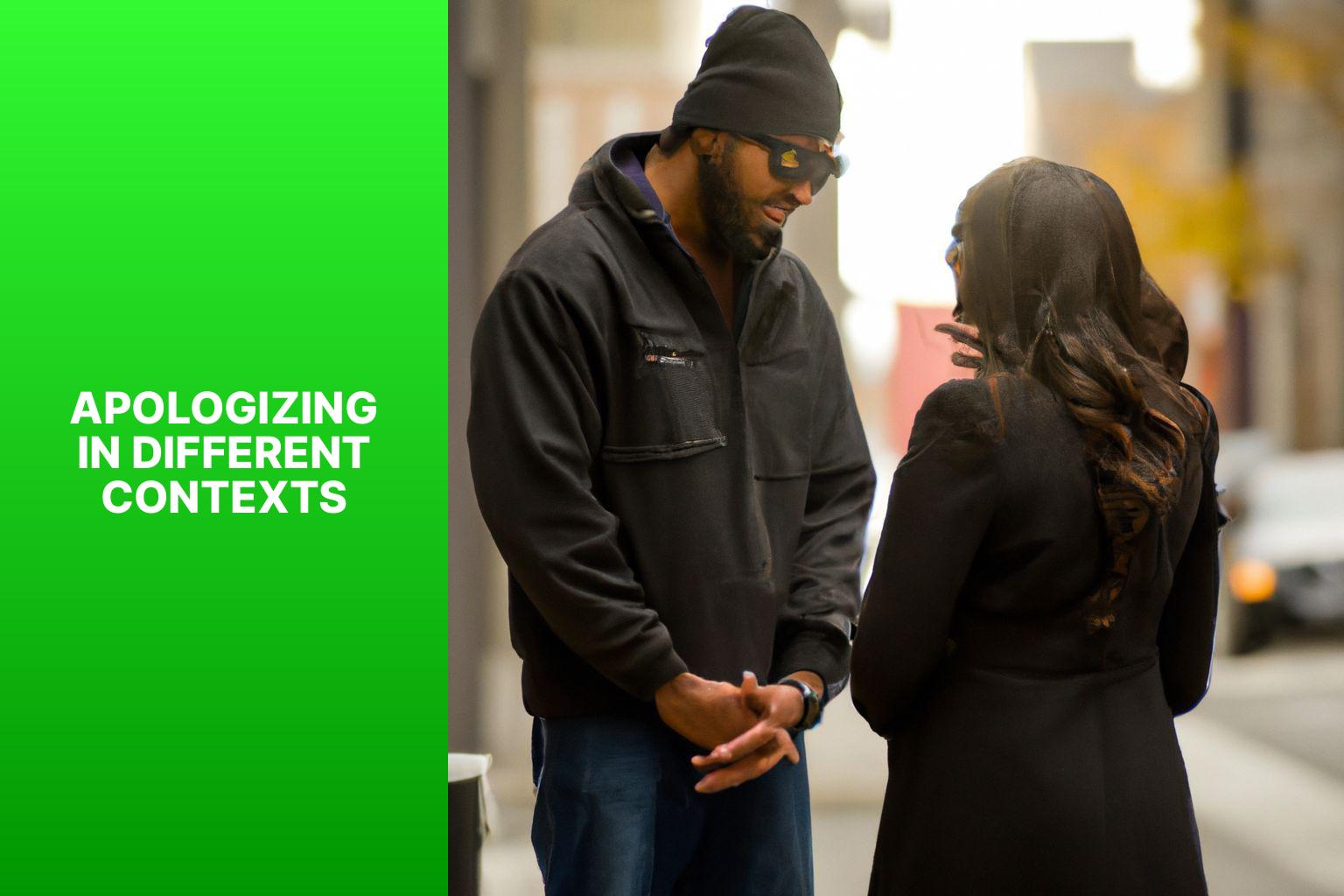Building Bridges: The Etiquette of Apologizing
Apologizing is a crucial aspect of maintaining healthy relationships and resolving conflicts. Understanding the etiquette of apologizing allows us to navigate various situations with grace and sincerity. Whether it’s apologizing in personal relationships, the workplace, or professional settings, building bridges through effective apologies plays a vital role in fostering understanding and reconciliation.
The importance of apologizing cannot be overstated. It demonstrates our willingness to take responsibility for our actions, acknowledges the impact we have on others, and shows respect for their feelings. A genuine apology encompasses more than just saying “I’m sorry.” It involves understanding the hurt caused, expressing remorse, and expressing a commitment to change.
Timing also plays a significant role in apologies. Timely apologies prevent the escalation of conflicts and allow for prompt resolution. A delayed apology can be viewed as insincere or lacking commitment to making amends.

Different contexts require different approaches to apologizing. In personal relationships, apologies should be sincere, heartfelt, and accompanied by actions that rebuild trust. In the workplace, apologies should be professional, accountable, and focused on finding solutions. In professional settings, apologies should be composed, respectful, and considerate of the reputation and integrity of individuals and organizations involved.
When seeking forgiveness for serious offenses, it is crucial to show accountability and regret. Offering a genuine apology involves accepting the consequences of our actions, acknowledging the pain caused, and expressing a sincere desire to change. Making amends and implementing a plan for growth and improvement further reinforce the commitment to rectifying our mistakes.
By understanding and practicing the etiquette of apologizing, we can bridge gaps, heal emotional wounds, and cultivate stronger connections with those around us. Effective apologies bring about reconciliation, growth, and a mutual understanding that helps us maintain healthy relationships and navigate conflicts with grace and empathy.
Key Takeaways:
- The Importance of Apologizing: Recognizing the significance of offering apologies helps maintain healthy relationships and resolves conflicts.
- Understanding the Etiquette of Apologizing: Knowing the components of a genuine apology, acknowledging the appropriate timing, and identifying when a public or personal apology is necessary.
- Common Mistakes to Avoid in Apologizing: Steering clear of excuses, defensiveness, and instead showing sincerity, empathy, and a willingness to make restitution if needed.
The Importance of Apologizing
Apologizing is of utmost importance when it comes to maintaining healthy relationships and resolving conflicts. It plays a vital role in fostering understanding, repairing any damage caused, and moving forward positively. There are several reasons why apologizing holds such significance:
- Restoring trust: Apologizing genuinely portrays your acknowledgement of the mistake made and expresses true regret for your actions. This, in turn, helps to rebuild trust and assures the other person that their feelings are valued and respected.
- Strengthening bonds: By apologizing, you showcase your commitment to the relationship. It shows that you take full responsibility for your actions and are willing to make amends, ultimately strengthening the bond between individuals involved.
- Resolving conflicts: Apologizing creates a space for both parties involved to express their feelings and address any grievances they may have. This paves the way for open and honest communication, leading to conflict resolution and possible reconciliation.
- Empathy and understanding: Apologizing involves recognizing the impact your actions had on the other person. It demonstrates empathy and highlights your genuine concern for their emotions and well-being.
- Personal growth: Apologizing requires self-reflection and self-awareness. It allows you to learn from your mistakes, grow as an individual, and cultivate healthier behaviors for the future.
Understanding the Etiquette of Apologizing
Apologizing is an art, and in this section, we’ll dive into the etiquette of apologies. From the importance of sincerity in a genuine apology to the timing of when to say sorry, we’ll explore the ins and outs of this crucial social skill. Plus, we’ll examine the differences between making a personal apology versus a public one. So, get ready to discover the dos and don’ts of apologizing that can help repair relationships and build bridges.
The Genuine Apology
The genuine apology is crucial for effective communication and conflict resolution. It involves taking responsibility and expressing remorse for the harm caused. A genuine apology requires sincerity and empathy.
The Genuine Apology means admitting fault without making excuses or defensiveness, showing genuine regret, and understanding the negative impact your actions had on others. It also means accepting accountability and avoiding shifting blame.
Considering restitution to make amends for the harm caused is an important aspect of The Genuine Apology. Expressing a willingness to learn from mistakes and make changes to prevent future recurrence further enhances the authenticity of The Genuine Apology.
Remember, The Genuine Apology is not just about seeking forgiveness; it’s about showing a sincere desire to rectify the situation. By following these principles of The Genuine Apology, you can foster understanding, rebuild trust, and strengthen relationships.
The Timeliness of Apologizing
The timeliness of apologizing is crucial. Apologizing promptly shows responsibility and sincerity.
- Timing matters: Apologize as soon as possible after a mistake or wrongdoing. Waiting too long can cause further damage and make the hurt party feel neglected. Aim to apologize within 24-48 hours of the incident.
- Recognize the impact: Acknowledge the timeliness of the apology by expressing awareness of the hurt or harm caused. Let the person know you understand the importance of addressing the situation promptly.
- Immediate action: Along with a timely apology, take immediate action to rectify the situation or prevent similar occurrences in the future. This shows commitment to change and alleviates concerns about future behavior.
- Consider the context: Different situations may require different levels of urgency in apologizing. For minor misunderstandings or conflicts, a timely apology may not be as critical. For major offenses or deeply hurtful actions, a more immediate apology is necessary.
- Respect the other person’s time: While it is important to apologize promptly, be mindful of the other person’s readiness to receive the apology. Pushing for an apology before they are ready may not be beneficial and can lead to further resentment.
Remember, the timeliness of an apology significantly impacts its effectiveness and the chance of rebuilding trust. Act promptly, show genuine remorse, and take appropriate action to resolve the issue.
The Personal Apology vs. Public Apology

Photo Credits @yourwhitestone
When apologizing, there are different approaches for personal and public apologies. Consider these points:
1. Intent: A personal apology is for a specific individual or small group, while a public apology addresses a larger audience.
2. Scope: A personal apology focuses on a specific incident, while a public apology can cover a broader range of issues.
3. Delivery: A personal apology is best delivered in person, through a phone call or a handwritten letter. A public apology is typically delivered through a public statement, press conference, or social media post.
4. Tone: A personal apology can be intimate and empathetic, tailored to the recipient. A public apology needs to be professional, sincere, and address public concerns.
5. Accountability: Both personal and public apologies require taking responsibility for one’s actions and acknowledging harm caused. In a public apology, a wider range of stakeholders and public opinion may need to be considered.
6. Restitution: Restitution or making amends may be needed in both personal and public apologies, but the nature and extent may vary. In a personal apology, focus is on repairing the relationship with the individual. In a public apology, it may involve policy changes or financial compensation.
7. Follow-up: After a personal apology, maintaining communication and efforts to rebuild trust are important. For a public apology, demonstrating a commitment to change and providing progress updates helps regain public confidence.
Understanding the differences between personal and public apologies can help individuals and organizations navigate these situations effectively, promoting genuine reconciliation and growth.
Common Mistakes to Avoid in Apologizing
Apologizing is an art, and mastering it can make a world of difference in our relationships. In this section, we’ll explore common mistakes to avoid when saying sorry. From steering clear of excuses and defensiveness to the importance of being sincere and empathetic, we’ll uncover the key elements behind a genuine apology. Additionally, we’ll discuss the significance of providing restitution when necessary, ensuring our apologies go beyond mere words and lead to meaningful resolutions. Let’s dive in and discover how to build bridges through the etiquette of apologizing.
Avoiding Excuses and Defensiveness
When apologizing, it is important to avoid making excuses or becoming defensive. Here are some key points to consider:
– Take responsibility: Own up to your mistake or wrongdoing. Acknowledge your role and accept the consequences.
– Be accountable: Show genuine remorse for your actions and the impact they may have caused. Avoid minimizing the situation or downplaying the other person’s feelings.
– Listen actively: When someone expresses their hurt or disappointment, listen without interrupting or becoming defensive. Validate their feelings and show empathy.
– Avoid justifying: Refrain from providing explanations that may sound like excuses. Accept that your actions were wrong and focus on finding a solution or making amends.
– Choose your words carefully: Use language that expresses understanding and sincerity. Avoid defensive phrases like “It wasn’t my fault” or “You’re overreacting”. Instead, say things like “I understand how my actions have hurt you” or “I take full responsibility for my behavior”.
– Offer a genuine apology: Apologize sincerely and directly, without making the other person feel guilty. Be specific about what you did wrong and how you plan to prevent similar incidents in the future.
– Make amends: If appropriate, offer to rectify the situation. This could involve taking actions to correct the mistake, providing compensation, or making necessary changes to prevent recurrence.
By avoiding excuses and defensiveness, you can demonstrate genuine remorse and a willingness to make things right. Approach the situation with empathy and a sincere desire to repair any harm caused.
Being Sincere and Empathetic
Incorporating keywords naturally in the provided text is important to convey the message effectively. When it comes to resolving conflicts and repairing relationships, being sincere and empathetic plays a crucial role. Here are some key points to consider:
1. Acknowledge the impact: Take responsibility for your actions and sincerely acknowledge the hurt or harm caused. Address the specific emotions or consequences experienced by the other parties involved.
2. Show genuine remorse: Express sincere regret for your behavior or actions. Make it clear that you understand why the other person is upset or hurt, and apologize for the pain you have caused.
3. Listen actively: Be attentive and responsive to the other person’s feelings and perspective. Allow them to express their thoughts and emotions without interruption, and show empathy by validating their experiences.
4. Validate emotions: Recognize the validity of the other person’s emotions. Let them know you understand how they feel and that their emotions are justified. Avoid dismissing or trivializing their feelings.
5. Avoid justifications or excuses: Refrain from making excuses or shifting blame. Focus on taking accountability for your actions and avoid minimizing the impact.
6. Offer restitution: If appropriate, provide a solution or offer restitution to make amends. This can include making reparations, correcting mistakes, or finding ways to prevent similar incidents in the future.
7. Learn and grow: Demonstrate a genuine commitment to change by outlining specific steps or actions you will take to prevent the same issue from happening again. Continuous improvement and personal growth can help rebuild trust.
Being sincere and empathetic in your apology creates an environment of understanding and compassion, paving the way for forgiveness and reconciliation.
Providing Restitution when Necessary
When it comes to providing restitution, it is crucial to take appropriate actions to make amends for any harm caused. Here are some key considerations in this process:
1. Act swiftly and decisively: Address the situation promptly and take immediate steps to rectify the damage.
2. Take responsibility: Accept responsibility for one’s actions. Acknowledge mistakes or wrongdoing and show genuine remorse.
3. Offer compensation: Provide restitution by offering financial reimbursement, replacing or repairing damaged property, or providing necessary support to those affected.
4. Show commitment to change: Demonstrate a sincere commitment to personal growth and learning from mistakes. Implement new policies or procedures to prevent similar incidents in the future.
5. Communicate openly and honestly: Transparency is key. Keep affected parties informed about the steps being taken and ensure clear, honest communication throughout the process.
6. Learn from the experience: Use the opportunity to learn and make meaningful changes. Seek feedback, conduct internal reviews, and implement necessary changes to prevent future occurrences.
By following these guidelines, individuals and organizations can demonstrate accountability and work towards rebuilding trust and repairing relationships.
Apologizing in Different Contexts

Photo Credits: Www.Moderngentlemanmagazine.Com by Kevin Scott
Apologizing in different contexts opens up a world of complexities and dynamics in our social interactions. From personal relationships to the workplace and professional settings, each sub-section offers a unique perspective on the etiquette of apologizing. Discover the intricacies of apologizing for personal transgressions, the power dynamics involved in apologizing at work, and the professional decorum required in public apologetic gestures. Get ready to navigate the delicate art of extending apologies in various realms of life.
Apologizing in Personal Relationships
When apologizing in personal relationships, consider the following factors to effectively mend any harm or misunderstanding:
- Timing: Apologize promptly after realizing the mistake or offense. Promptness shows sincerity and respect for the other person’s feelings.
- Genuine and sincere apology: Express remorse without making excuses or shifting blame. Taking responsibility for one’s actions is crucial in rebuilding trust.
- Empathy and understanding: Acknowledge the impact of your actions on the other person and validate their feelings. This helps cultivate empathy and show that you care.
- Active listening: Give the other person an opportunity to express their feelings and concerns. Listen attentively without interrupting, demonstrating your willingness to understand their perspective.
- Restitution and making amends: Depending on the situation, offer to make things right by taking appropriate actions. This could involve providing a heartfelt apology, making a sincere promise to change, or offering a thoughtful gesture to show that you value the relationship.
Remember, apologizing in personal relationships requires honesty, vulnerability, and humility. It may also take time for the other person to heal and forgive. Therefore, it is important to be patient and allow space for open communication and emotional healing.
Apologizing in the Workplace
Apologizing in the workplace is crucial for maintaining relationships and nurturing a positive work environment. Here are some important considerations to keep in mind when offering a professional apology:
- Promptly address mistakes: It is essential to take immediate action and apologize to prevent any further damage.
- Show sincerity and empathy: When apologizing, it is important to genuinely express remorse and demonstrate empathy towards the affected person.
- Offer restitution when appropriate: Take steps to rectify the mistakes, provide assistance, or find a solution to repair any damage caused.
- Learn from your mistakes: Reflect on the errors made and take measures to prevent similar situations from occurring in the future.
- Seek forgiveness and make amends: Allow the person you have harmed to express their emotions and extend forgiveness. Collaborate to find a resolution that satisfies both parties.
By following these guidelines, you can effectively apologize in the workplace and cultivate strong professional relationships. Taking responsibility, learning, and personal growth are essential for building and maintaining trust at work.
Apologizing in Professional Settings
When apologizing in professional settings, follow these guidelines for a sincere and effective apology:
1. Take immediate action: Be prompt in addressing mistakes or wrongdoing. This shows accountability and commitment to resolving the issue.
2. Accept responsibility: Acknowledge your role in the situation and take ownership of the mistake. Avoid making excuses or blaming others.
3. Be sincere and empathetic: Show genuine remorse for any harm caused and express empathy towards those affected. This helps rebuild trust and maintain positive relationships with colleagues.
4. Offer a solution: Along with expressing remorse, provide a plan for rectifying the situation or preventing similar incidents in the future. This demonstrates commitment to growth and improvement.
5. Seek feedback and learn from the experience: Be open to receiving feedback from others involved and use it to cultivate personal and professional development. This shows a willingness to learn from mistakes and ensures continuous growth.
Remember, maintaining professionalism and respect is crucial when apologizing in professional settings. By following these guidelines, you can navigate challenging situations with integrity and foster a positive work environment.
Apologizing for Serious Offenses

Photo Credits @_that_woman__
When it comes to serious offenses, there’s a whole new level of importance attached to a sincere apology. In this section, we’ll delve into the art of apologizing for serious offenses. We’ll explore how demonstrating accountability and regret, developing a plan for change and growth, and seeking forgiveness and making amends can pave the way towards healing and reconciliation. So, let’s dive in and uncover the essential elements of offering a heartfelt apology in the face of significant transgressions.
Show Accountability and Regret
“Showing accountability and regret is crucial when apologizing. Here are key ways to demonstrate these qualities:
1. Take responsibility: Acknowledge your harmful actions or words without excuses or blame shifting.
2. Express genuine remorse: Clearly convey your regret and sorrow for the consequences, using active language to emphasize the impact on the other person.
3. Show empathy: Demonstrate understanding and acknowledgment of the hurt person’s emotions and feelings.
4. Offer a sincere apology: Use heartfelt words to explicitly express regret and avoid insincere apologies.
5. Be open to discussion: Listen to the other person’s perspective, creating a safe space for them to express their feelings.
6. Seek to make amends: Take appropriate actions to right the wrong and prevent similar situations in the future, demonstrating commitment to personal growth.
By following these steps, you can effectively show accountability and regret, fostering understanding and healing.”
Create a Plan for Change and Growth
When creating a plan for change and growth in apologizing, take specific steps to show commitment to improvement and avoiding similar mistakes in the future.
– Reflect on the situation: Take time to understand what went wrong and why an apology was necessary.
– Identify areas for improvement: Analyze the situation and identify specific areas where changes can be made to prevent similar mistakes in the future. This could include improving communication skills, setting boundaries, or seeking professional development. For more insights on the etiquette of apologizing, check out Building Bridges: The Etiquette of Apologizing.
– Set realistic goals: Determine specific actions that can address the identified issues. Set achievable goals within a given timeframe.
– Develop an action plan: Break down goals into actionable steps. Create a detailed plan outlining tasks, responsibilities, and deadlines.
– Seek support: Reach out to mentors, coaches, or trusted friends who can provide guidance, support, or accountability.
– Implement the plan: Put the plan into action and follow through with each step. Be consistent and committed to the process of change and growth.
– Evaluate progress: Regularly assess progress and make adjustments if needed. Reflect on changes made and consider their impact on behavior and relationships.
– Continuously learn and grow: Apologizing is an ongoing process of learning from mistakes and striving to do better. Stay open to feedback, seek opportunities for growth, and remain committed to personal and professional development.
Seek Forgiveness and Make Amends

Photo Credits @yourwhitestone
- Reflect on your actions: Take time to deeply reflect on the actions that led to the need for an apology. Understand the impact on the offended party.
- Take responsibility: Acknowledge mistakes and take full responsibility for actions. Avoid making excuses.
- Seek forgiveness and make amends: Show sincere remorse. Apologize sincerely, demonstrating understanding of the harm caused.
- Offer a heartfelt apology: Use clear and concise language to express your apology. Avoid vague statements.
- Make amends: Seek ways to make amends for the harm caused. This may involve compensating for losses, offering support, or taking preventative measures.
- Listen actively: Be willing to listen to the feelings and perspectives of the offended party. Allow them to express their emotions and concerns without interruption.
- Be patient: Recognize that forgiveness takes time. Respect the offended party’s need for space and time to process their emotions and decide whether to forgive.
- Show genuine change: Demonstrate through actions a commitment to personal growth and change. Take steps to prevent similar mistakes in the future.
- Respect boundaries: Understand and respect the boundaries set by the offended party. Accept their decision if they are not ready to forgive or reconcile.
- Learn from the experience: Use the situation as an opportunity for personal growth and learning. Reflect on how to prevent similar situations in the future.
Frequently Asked Questions
What are the basic principles of a successful apology?
A successful apology should be sincere, concise, and focused on accepting full responsibility for one’s actions. It should avoid shifting the blame onto the recipient or using the word “but” to undermine its sincerity.
How can a poorly conceived and executed apology make things worse?
A poorly conceived and executed apology can make things worse by coming across as insincere or lacking remorse. It can make the injured party feel worse and may even repeat the behavior that caused the hurt.
How can teaching children the proper skills and language for apologizing be beneficial?
Teaching children the proper skills and language for apologizing can empower them with valuable life skills. It helps them understand the impact of their actions, demonstrate empathy, and build bridges in their relationships.
What are some important elements to consider when delivering an apology?
When delivering an apology, it is important to look at the person, use their name, and apologize for the specific action that caused the hurt. The injured party should respond with phrases like “thanks for saying sorry,” “apology accepted,” or “I forgive you” to truly build bridges.
What can a sincere and well-executed apology accomplish?
A sincere and well-executed apology has the power to heal and repair relationships. It provides a basis for letting go, moving on, and can serve as the “super glue of life” by demonstrating genuine remorse and a commitment to change.
How can crafting effective apologies be beneficial in mitigating or recovering from reputation-damaging incidents?
Crafting effective apologies can be beneficial in mitigating or recovering from reputation-damaging incidents. By using models like the “6 A’s” and considering the authenticity and timing of an apology, communication practitioners can build bridges, regain trust, and repair their reputation.
